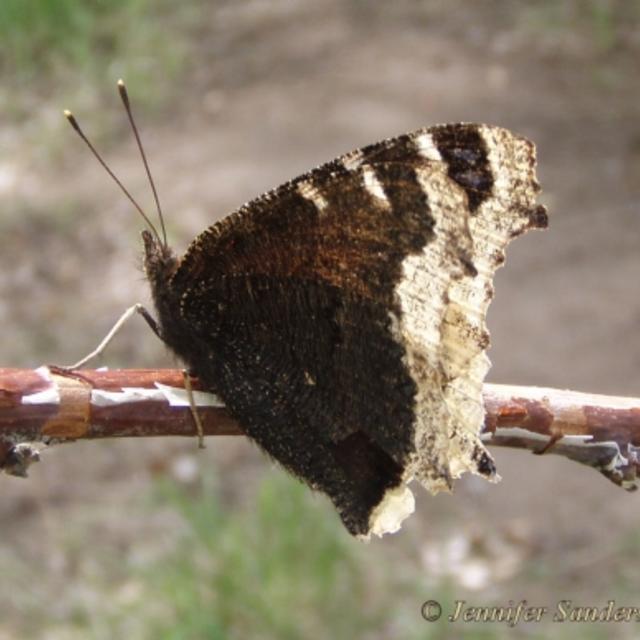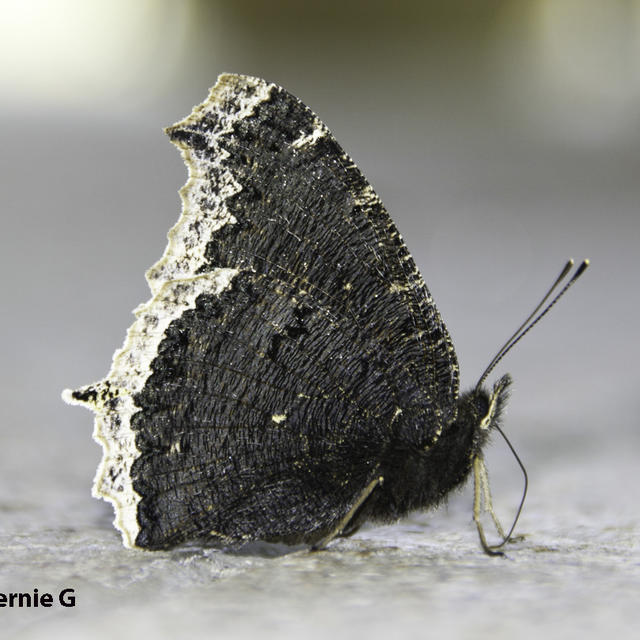Mourning Cloak
Nymphalis antiopa (Linnaeus, 1758)
Family: Nymphalidae
Subfamily: Nymphalinae
Identification: Short projections on both wings, borders irregular. Upperside is purple-black with a wide, bright yellow border on outer margins, and a row of iridescent blue spots at the inner edge of the border.
Wing Span: 2 1/4 - 4 inches (5.7 - 10.1 cm).
Life History: Overwintered adults mate in the spring, the males perching in sunny openings during the afternoon to wait for receptive females. Eggs are laid in groups circling twigs of the host plant. Caterpillars live in a communal web and feed together on young leaves, then pupate and emerge as adults in June or July. After feeding briefly, the adults estivate until fall, when they re-emerge to feed and store energy for hibernation. Some adults migrate south in the fall.
Flight: Usually one flight from June-July.
Caterpillar Hosts: Willows including black willow (Salix nigra), weeping willow (S. babylonica), and silky willow (S. sericea); also American elm (Ulmus americana), cottonwood (Populus deltoides), aspen (P. tremuloides), paper birch (Betula papyrifera), and hackberry (Celtis occidentalis). Older caterpillars wander about and may be found on plants that they do not eat.
Adult Food: Mourning Cloaks prefer tree sap, especially that of oaks. They walk down the trunk to the sap and feed head downward. They will also feed on rotting fruit, and only occasionally on flower nectar.
Habitat: Because Mourning Cloaks roam and migrate, they are found almost anywhere that host plants occur including woods, openings, parks, and suburbs; and especially in riparian areas.
Range: All of North America south of the tundra to central Mexico; rarely in the Gulf States and peninsular Florida. Also native to temperate Eurasia. Comments: Adults live 10-11 months and may be our longest lived butterfly.
Conservation: Not required.
NCGR: G5 - Demonstrably secure globally, though it may be quite rare in parts of its range, especially at the periphery.
Management Needs: Occasionally may be necessary to control caterpillar damage to shade trees.
Get your BAMONA Gear!
Please donate!
We depend on donations to keep Butterflies and Moths of North America freely available. We want to express our gratitude to all who showed their support by making a contribution this year. You can donate to support this project at any time.
Advertise with us!
Do you have a product or service that you think would interest BAMONA users? If you would like to advertise on this website, contact us by email, or use the contact form and select the "Advertising" category.
Verified Sightings
Displaying 1 - 24 of 8724 verified sightings

Observation date: Jan 24, 2025
Submitted by: Patricia12
Region: Ventura County, California, United States
Verified by: Ken Davenport
Verified date: Jan 26, 2025

Observation date: Oct 24, 2024
Submitted by: Christinalea
Region: Texas, Wichita County, United States
Verified by: jwileyrains
Verified date: Oct 29, 2024

Observation date: Aug 23, 2024
Submitted by: John Terpstra
Region: Ontario, Canada
Verified by: curtis.lehman
Verified date: Oct 17, 2024

Observation date: Jun 14, 2024
Submitted by: ncrosbyrd
Region: Apache County, Arizona, United States
Verified by: John Saba
Verified date: Oct 09, 2024

Observation date: Oct 03, 2024
Submitted by: Sheilabean
Region: Texas, Tarrant County, United States
Verified by: jwileyrains
Verified date: Oct 03, 2024

Observation date: Sep 10, 2024
Submitted by: pattiep9
Region: Oneida County, Wisconsin, United States
Verified by: jmgesell
Verified date: Sep 12, 2024

Observation date: Apr 07, 2021
Submitted by: Al R
Region: Ontario, Canada
Verified by: jmgesell
Verified date: Sep 10, 2024

Observation date: Jul 30, 2024
Submitted by: John Terpstra
Region: Ontario, Canada
Verified by: jmgesell
Verified date: Sep 05, 2024

Observation date: Aug 14, 2024
Submitted by: ElaineO
Region: Newfoundland and Labrador, Canada
Verified by: jmgesell
Verified date: Aug 16, 2024

Observation date: May 07, 2024
Submitted by: dvollmar
Region: Denton County, Texas, United States
Verified by: jwileyrains
Verified date: Aug 09, 2024

Observation date: Jun 11, 2023
Submitted by: huntybunty
Region: Alberta, Canada
Verified by: jmgesell
Verified date: Aug 09, 2024

Observation date: Jul 04, 2020
Submitted by: Alison Davies
Region: San Diego County, California, United States
Verified by: Ken Davenport
Verified date: Aug 02, 2024

Observation date: Jul 28, 2024
Submitted by: Cactuswren1976
Region: Santa Fe County, New Mexico, United States
Verified by: jwileyrains
Verified date: Jul 29, 2024

Observation date: Jul 18, 2024
Submitted by: MinPinLord
Region: Alberta, Canada
Verified by: J_Martineau
Verified date: Jul 29, 2024

Observation date: May 20, 2024
Submitted by: Quentin Betencourt
Region: Quebec, Canada
Verified by: jwileyrains
Verified date: Jul 24, 2024

Observation date: Apr 27, 2024
Submitted by: Sheilabean
Region: Texas, Tarrant County, United States
Verified by: jwileyrains
Verified date: Jul 18, 2024

Observation date: Jul 14, 2024
Submitted by: Ejordan9611
Region: San Diego County, California, United States
Verified by: Ken Davenport
Verified date: Jul 14, 2024

Observation date: Jul 08, 2024
Submitted by: NorthPeace
Region: British Columbia, Canada
Verified by: jwileyrains
Verified date: Jul 12, 2024

Observation date: May 19, 2024
Submitted by: bonfrey
Region: Socorro County, New Mexico, United States
Verified by: stevecary
Verified date: Jul 03, 2024

Observation date: Jun 06, 2024
Submitted by: Cascade Colors
Region: Grand County, Colorado, United States
Verified by: mikefisher
Verified date: Jul 01, 2024

Observation date: Jun 05, 2024
Submitted by: Cascade Colors
Region: Grand County, Colorado, United States
Verified by: mikefisher
Verified date: Jul 01, 2024

Observation date: May 24, 2024
Submitted by: pgrew1@unl.edu
Region: Penobscot County, Maine, United States
Verified by: John Calhoun
Verified date: Jun 30, 2024

Observation date: Jun 26, 2024
Submitted by: Tom Dudones
Region: Franklin County, New York, United States
Verified by: jmgesell
Verified date: Jun 28, 2024

Observation date: Jun 27, 2022
Submitted by: vogelbild
Region: DuPage County, Illinois, United States
Verified by: rogerdowner
Verified date: Jun 28, 2024
- 1 of 364
- next ›




















